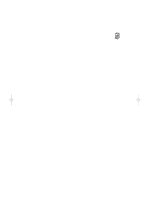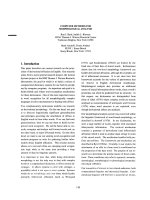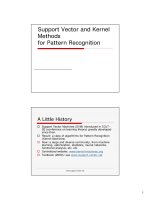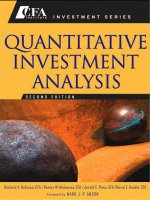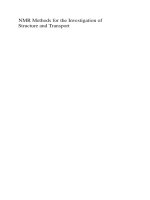Efficient mesh freee methods for plate analysis
Bạn đang xem bản rút gọn của tài liệu. Xem và tải ngay bản đầy đủ của tài liệu tại đây (11.56 MB, 332 trang )
Effective Mesh-free Methods for Plate Analysis
Wu Wenxin
NATIONAL UNIVERSITY OF SINGAPORE
2007
Effective Mesh-free Methods for Plate Analysis
Wu Wenxin
(B. Eng., Shanghai Jiaotong University)
A THESIS SUBMITTED
FOR THE DEGREE OF DOCTOR OF PHILOSOPHY
DEPARTMENT OF MECHANICAL ENGINEERING
NATIONAL UNIVERSITY OF SINGAPORE
2007
To Shu Rong and Jia Xi
I
Acknowledgements
I would like to express my deepest gratitude to my supervisors, Professor C. Shu and
Professor C. M. Wang, for their invaluable guidance, encouragement and patience
throughout this study.
My gratitude also extends to my wife and daughter for their support and
encouragement over my PhD candidature period.
Finally, I wish to thank the National University of Singapore for providing me with a
research scholarship, which makes this study possible.
Wu Wenxin
II
Table of Contents
Acknowledgements I
Table of Contents II
Summary XI
List of Tables XIII
List of Figures XVII
Notations XXV
Abbreviations XXVIII
Chapter 1 Introduction 1
1.1 Background of Plate Analysis 1
1.1.1 Introduction to Plate Theories 1
1.1.2 Analytical Methods for Plate Analysis 4
1.1.3 Numerical Methods for Plate Analysis 6
1.2 Literature Review on Mesh-free Methods 8
1.2.1 Disadvantages of Traditional Numerical Methods 9
1.2.2 Concept of Mesh-free 11
1.2.3 Classification of Mesh-free Methods 13
1.2.3.1 A Particle Method: Smoothed Particle Hydrodynamics (SPH) 17
1.2.3.2 Mesh-free Methods of Integral Type 18
1.2.3.3 Mesh-free Methods of Non-Integral Type 20
1.2.4 Desirable Mesh-free Methods for Plate Analysis 24
1.3 Objectives of Thesis 25
III
1.4 Organization of Thesis 25
Chapter 2 LSFD Method and LRBFDQ Method 29
2.1 Least Squares-based Finite Difference (LSFD) Method 29
2.1.1 Conventional Finite Difference Method (FDM) 29
2.1.2 Least Squares-based Finite Difference (LSFD) Method 30
2.1.2.1 Formulas for Derivative Discretization 30
2.1.2.2 Chain Rule for Discretization of Derivatives 37
2.1.2.3 LSFD Formulas in Local (n, t)-Coordinates at Boundary 39
2.1.2.4 Numerical Analysis of a Sample PDE Using LSFD 41
2.1.3 Function Value Problems and Eigenvalue Problems 45
2.1.4 Concluding Remarks 46
2.2 Local Radial Basis Function-based Differential Quadrature (LRBFDQ) Method 47
2.2.1 Radial Basis Functions (RBFs) and Interpolation Using RBFs 47
2.2.2 Traditional RBF-based Schemes for Solving PDEs 50
2.2.3 Local Radial Basis Function-based Differential Quadrature (LRBFDQ)
Method 51
2.2.3.1 Formulas for Derivative Discretization 51
2.2.3.2 LRBFDQ Formulas in Local (n, t)-Coordinates at Boundary 54
2.2.3.3 Numerical Analysis of Sample PDEs Using LRBFDQ 55
2.2.4 Concluding Remarks 72
IV
Chapter 3 Applications of LSFD and LRBFDQ for Solving Helmholtz Equations . 73
3.1 TM Modes and TE Modes in Metallic Waveguides – Application of LSFD 74
3.1.1 Definition of Problem 74
3.1.2 Numerical Algorithm 75
3.1.2.1 Numerical Discretization by LSFD 75
3.1.2.2 Dealing with Singular Points on Boundary
Γ
78
3.1.3 Results and Discussion 79
3.1.3.1 Rectangular Waveguide 79
3.1.3.2 Double-Ridged Waveguide 81
3.1.3.3 L-Shaped Waveguide 82
3.1.3.4 Single-Ridged Waveguide 83
3.1.3.5 Coaxial Rectangular Waveguide 85
3.1.3.6 Vaned Rectangular Waveguide 86
3.1.4 Concluding Remarks 87
3.2 Free Vibration of Uniform Membranes – Application of LRBFDQ 87
3.2.1 Definition of Problem 87
3.2.2 Numerical Discretization by LRBFDQ 88
3.2.3 Results and Discussion 89
3.2.3.1 Circular Membrane 90
3.2.3.2 Rectangular Membrane 92
3.2.3.3 Half Circle+Triangle Membrane 94
3.2.3.4 L-Shaped Membrane 96
3.2.3.5 Concave Membrane with High Concavity 98
V
3.2.3.6 Multi-Connected Membrane 101
3.2.4 Concluding Remarks 103
Chapter 4 Plate Theories and Numerical Implementation 105
4.1 Thin Plate Theory for Small Deflection Problems 105
4.1.1 Displacement Components 105
4.1.2 Strain-Displacement Relations 106
4.1.3 Stresses and Stress Resultants 107
4.1.4 Differential Equation for Transversely Loaded Plates 109
4.1.5 Differential Equation for Freely Vibrating Plates 113
4.1.6 Differential Equation for Buckling of Plates 114
4.1.6.1 Plates under Combined Transverse and In-Plane Loads 114
4.1.6.2 Buckling of Plates 117
4.1.7 Boundary Conditions 118
4.1.8 Numerical Implementation 120
4.1.8.1 Discretization of Governing Equations 120
4.1.8.2 Implementation of Boundary Conditions 123
4.2 Thin Plate Theory for Large Deflection Problems 133
4.2.1 Bending Equations of Plates with Large Deflections 133
4.2.2 Equations of Motion for Large-Amplitude Free Vibration of Thin Plates 136
4.2.3 Boundary Conditions 137
4.2.4 Numerical Implementation 137
4.2.4.1 Bending of Plates with Large Deflections 137
VI
4.2.4.2 Large Amplitude Free Vibration of Plates 138
4.3 Shear Deformable Plate Theory for Small Deflection Problems 143
4.3.1 Displacement Components 144
4.3.2 Strain-Displacement Relations 144
4.3.3 Stress Resultant-Displacement Relations 145
4.3.4 Governing Equations of Motion 146
4.3.5 Governing Equations for Bending 147
4.3.6 Governing Equations for Free Vibration 148
4.3.7 Boundary Conditions 149
4.3.8 Numerical Implementation Using LSFD Method 151
4.3.8.1 Discretization of Governing Equations 151
4.3.8.2 Implementation of Boundary Conditions 152
Chapter 5 LSFD for Thin Plate Vibration 158
5.1 Small-Amplitude Free Vibration of Thin Plates with Arbitrary Shapes 159
5.1.1 Simply Supported and Clamped Plates 160
5.1.1.1 Introduction 160
5.1.1.2 Results and Discussion 162
• Symmetric Trapezoidal Plates 162
• Symmetric Parabolic Trapezoidal Plates 162
• Rhombic Plates 164
• Sectorial Plates 165
• Circular and Elliptical Plates 167
VII
• Annular Plates 170
5.1.1.3 Concluding Remarks 170
5.1.2 Completely Free Plates 172
5.1.2.1 Introduction 172
5.1.2.2 Problem Definition and Numerical Solution 173
5.1.2.3 Results and discussion 174
• Frequencies of Circular and Elliptical Plates 175
• Frequencies of Lifting-Tab Shaped and
45
o
Right Triangular Plates 176
•
Verification of Radii of Nodal Circles of the Circular Plate 178
•
Verification of Natural Boundary Conditions 179
•
Distributions of Mode Shapes and Modal Stress Resultants 183
•
Peak Values of Modal Deflections and Modal Stress Resultants 191
5.1.2.4 Concluding Remarks 193
5.2 Large-Amplitude Free Vibration of Thin Plates with Arbitrary Shapes 194
5.2.1 Motivation and Literature Review 194
5.2.2 Results and discussion 196
5.2.2.1 Square Plates 197
5.2.2.2 Circular Plates 201
5.2.2.3 L-Shaped Plate 202
5.2.2.4 Square Plates with Semi-Circular Edge Cuts 204
5.2.3 Concluding Remarks 206
VIII
Chapter 6 LSFD for Bending of Thin Plates
208
6.1 Simply Supported Rectangular Plates 209
6.1.1 Sinusoidal Load 209
6.1.1.1 Definition of Problem 209
6.1.1.2 Results and Discussion 210
6.1.2 Uniform Load 214
6.2 Continuous Rectangular Plate 217
6.2.1 Definition of Problem 217
6.2.2 Numerical Algorithm 218
6.2.3 Results and Discussion 222
6.3 Sectorial Plates 229
6.3.1 Problem Definition 229
6.3.2 Numerical Algorithm 230
6.3.3 Results and Discussion 231
Chapter 7 LSFD for Buckling of Highly Skewed Plates
235
7.1 Motivation and Literature Review 235
7.2 Problem Definition 237
7.3 Numerical Algorithm 238
7.4 Results and Discussion 241
7.4.1 Verification of the LSFD Method 241
7.4.1.1 Convergence Study of
k-
Values for Two SSSS Rhombic Plates with
45
θ
=
o
and
80
θ
=
o
241
IX
7.4.1.2 Comparison Study of
k
-Values for Rhombic Plates with Small Skew
Angles 243
7.4.2 LSFD Results for Rhombic Plates with Very Large Skew Angles 244
7.5 Concluding Remarks 249
Chapter 8 LSFD for Vibration of Mindlin Plates
250
8.1 Motivation and Literature Review 250
8.2 Problem Definition 252
8.3 Numerical Algorithm 253
8.4 Results and Discussion 254
8.4.1 Varification of LSFD Method 254
8.4.1.1 Comparison Study Using an Elliptical Plate 254
8.4.1.2 Comparison Study Using a Circular Plate 256
8.4.2 Solution of a Rectangular Plate That Models VLFS 259
8.4.2.1 Comparison in Accuracy of LSFD Solution with Ritz Solution 259
8.4.2.2 Comparison in Computational Cost of LSFD Solution with Ritz
Solution 267
8.5 Concluding Remarks 268
Chapter 9 Conclusions and Recommendations
270
9.1 Conclusions 270
9.2 Recommendations for Future Research 275
X
References
276
Appendix
293
List of Publications
300
XI
Summary
In recent years, mesh-free methods have been developed for solving partial
differential equations (PDEs) effectively. These methods are invented in order to
overcome difficulties that may be faced when solving PDEs using traditional mesh-based
numerical methods. These difficulties include (1) modeling of complex domain shapes,
(2) accurate approximation of high order derivatives, (3) capturing of steep variations of
functions and derivatives, and (4) implementation of multiple boundary conditions and
internal restraints. These difficulties may be due to (a) the use of mesh along coordinate
directions such as in FDM and DQM, or (b) the use of elements such as in FEM and
FVM, or (c) the use of global trial functions such as in the Ritz method, or (d) weak form
of PDEs to be solved. Most mesh-free methods are used for solving weak form of PDEs.
When using these methods, the implementation of multiple boundary conditions is still a
difficulty since the natural boundary conditions are not enforced in the solution process.
The earliest foundation for the development of two mesh-free methods, namely the
least squares-based finite difference (LSFD) method and the local radial basis function-
based differential quadrature (LRBFDQ) method, was laid by Ding
et al
. (2004) and Shu
et al
. (2003). In this thesis, the development of these two methods is advanced further, i.e.
high order schemes of the LSFD method are introduced, the chain rule for discretization
of high order derivatives is proposed, the LSFD and LRBFDQ formulations in terms of
local (
n, t
)-coordination system at boundary are developed, a practical approach for
searching a proper value of the shape parameter in the LRBFDQ method is proposed. By
XII
making use of these new developments in conjunction with the property of local mesh-
free approximation and the enforcement of all boundary conditions, the aforementioned
unfavorable factors (a) to (d) have been successfully removed, and consequently the
aforementioned difficulties (1) to (4) in solving PDEs have been overcome to a great
degree by using these two methods.
In this thesis, a wide range of plate problems and other engineering problems with
various complexities have been solved. These problems include bending, free vibration
and buckling analyses of thin plates, large-amplitude free vibration of thin plates, free
vibration of Mindlin plates, characteristic analysis of metallic waveguides, and free
vibration of uniform membranes. The complexities associating with these problems
correspond actually to the difficulties (1) to (4) mentioned above in solving PDEs. For
example, the governing equations for plates in the classical thin plate theory are fourth-
order PDEs; the plate shapes are arbitrary; there are two boundary conditions for a plate
edge; and in the free edge region of a thin plate, the variation of stresses is very steep, etc.
These studies demonstrate the accuracy and versatility of the two mesh-free methods
after the new developments in this thesis have been made.
XIII
List of Tables
Table 2.1 Lower limitation of number of supporting points for different LSFD
schemes 44
Table 3.1 Analytical and LSFD cutoff wavenumbers of TE modes of rectangular
waveguide: Case 1:
2232, F-9)
N
= (
; Case 2:
2232, F-14)
N
= (
; Case 3:
3341, F-9)
N
= (
80
Table 3.2 Cutoff wavenumbers for the double-ridged waveguide 82
Table 3.3 Cutoff wavenumbers of the L-shaped waveguide 83
Table 3.4 Cutoff wavenumbers of the single-ridged waveguide 84
Table 3.5 Cutoff wavenumbers of the coaxial rectangular waveguide 85
Table 3.6 Cutoff wavenumbers of the vaned rectangular waveguide 86
Table 3.7 Comparison of wavenumbers of the circular membrane (
1
R
=
) obtained by
LRBFDQ method, the exact method, Kang (1999), and FEM 91
Table 3.8 Comparison of wavenumbers of the rectangular membrane (1.2
×
0.9)
obtained by LRBFDQ method, the exact method, Kang (1999), and FEM 93
Table 3.9 Comparison of wavenumbers of the half circle+triangle membrane obtained
by LRBFDQ method, Kang (1999), and FEM 95
Table 3.10 Comparison of wavenumbers of the L-shaped membrane obtained by
LRBFDQ method, Kang (2000), and FEM 97
Table 3.11 Comparison of wavenumbers of the concavely shaped membrane obtained
by LRBFDQ method, Kang (2000), and FEM 99
Table 3.12 Comparison of wavenumbers of the multi-connected membrane obtained
by LRBFDQ method, Kang (2000), and FEM 102
Table 5.1 First six vibration frequencies of a symmetric trapezoidal plate 163
Table 5.2 First six vibration frequencies of the symmetric parabolic trapezoidal plate
with various boundary conditions 164
Table 5.3 First six vibration frequencies of simply supported rhombic plates 165
Table 5.4 First six vibration frequencies of clamped rhombic plates 166
XIV
Table 5.5 First six vibration frequencies of a sectorial plate 167
Table 5.6 First six vibration frequencies of clamped sectorial plates 168
Table 5.7 First six vibration frequencies of an eccentric sectorial plate 169
Table 5.8 First six vibration frequencies of clamped circular and elliptical plates 169
Table 5.9 First four vibration frequencies of an annular plate 171
Table 5.10 LSFD solution for the first six frequencies of completely free circular and
elliptic plates 177
Table 5.11 LSFD solution for the first six frequencies of the completely free lifting-
tab shaped plate 178
Table 5.12 LSFD solution for the first six frequencies of the completely free 45° right
triangular plate 178
Table 5.13 Radii of nodal circles
r a
ρ
=
for a completely free circular plate 179
Table 5.14 Verification of boundary conditions
0
n
M
=
and
0
n
V
=
of the completely
free circular plate 182
Table 5.15 Verification of boundary conditions
0
n
M
=
and
0
n
V
=
of the completely
free elliptical plate 183
Table 5.16 Verification of boundary conditions
0
n
M
=
and
0
n
V
=
of the completely
free lifting-tab shaped plate 183
Table 5.17 Verification of boundary conditions
0
n
M
=
and
0
n
V
=
of the completely
free 45° right triangular plate 183
Table 5.18 Peak values and corresponding locations of modal displacements
W
,
modal principal bending moments
x
M
′
and
y
M
′
, maximum modal
twisting moments
x y
M
′′ ′′
and maximum modal shear forces
x
Q
′′′
for
completely free circular plate 191
Table 5.19 Peak values and corresponding locations of modal displacements
W
,
modal principal bending moments
x
M
′
and
y
M
′
, maximum modal
twisting moments
x y
M
′′ ′′
and maximum modal shear forces
x
Q
′′′
for
completely free elliptical plate 192
XV
Table 5.20 Peak values and corresponding locations of modal displacements
W
,
modal principal bending moments
x
M
′
and
y
M
′
, maximum modal
twisting moments
x y
M
′′ ′′
and maximum modal shear forces
x
Q
′′′
for
completely free lifting-tab shaped plate 192
Table 5.21 Peak values and corresponding locations of modal displacements
W
,
modal principal bending moments
x
M
′
and
y
M
′
, maximum modal
twisting moments
x y
M
′′ ′′
and maximum modal shear forces
x
Q
′′′
for
completely free 45° right triangular plate 193
Table 5.22 Linear frequency parameters (
2
L L
a h D
λ ω ρ
=
) and period ratios
(
NL L
T T
) of a simply supported square plate 198
Table 5.23 Linear frequency parameters (
2
L L
a h D
λ ω ρ
=
) and period ratios
(
NL L
T T
) of a clamped square plate 200
Table 5.24 Linear frequency parameters (
2
L L
a h D
λ ω ρ
=
) and period ratios
(
NL L
T T
) for the fundamental modes of a square plate with different
boundary conditions 201
Table 5.25 Linear frequency parameters (
2
L L
R h D
λ ω ρ
=
) and period ratios
(
NL L
T T
) for the fundamental modes of a circular plate 202
Table 5.26 Linear frequency parameters (
2
L L
a h D
λ ω ρ
=
,
2
a
=
) and period ratios
(
NL L
T T
) for the fundamental mode of the L-shaped plate 203
Table 5.27 Linear frequency parameters (
2
L L
a h D
λ ω ρ
=
) and period ratios
(
NL L
T T
) of the simply supported square plate with edge cuts
(
2 0.4
r a =
) 205
Table 5.28 Linear frequency parameters (
2
L L
a h D
λ ω ρ
=
) and period ratios
(
NL L
T T
) of the clamped square plate with edge cuts (
2 0.4
r a =
) 206
Table 6.1 Comparison between LSFD solution and exact solution to the simply
supported square plate under the sinusoidal lateral load 211
Table 6.2 Comparison between LSFD solution and exact solution to the simply
supported square plate under the uniform lateral load 215
XVI
Table 6.3 The extreme values of deflections and stress resultants in the continuous
rectangular plate loaded in region 1 229
Table 6.4 The extreme values of deflections and stress resultants in the annular
sectorial plate 232
Table 6.5 Comparison of bending results for SCSC annular sectorial plate (
6
α π
=
,
0.5
b a =
) 234
Table 7.1 Comparison of buckling factors
k
for SSSS rhombic plates with small
skew angles 243
Table 7.2 Comparison of buckling factors
k
for CCCC rhombic plates with small
skew angles 244
Table 7.3 Convergence of LSFD results for buckling factors k of rhombic plates with
very large skew angles (Case I) 244
Table 7.4 Convergent LSFD results for buckling factors
k
for rhombic plates with
very large skew angles (Case I, upper and/or lower edges are free) 247
Table 7.5 Buckling factors
k
′
for rhombic plates (Case II) 248
Table 8.1 First six frequency parameters for an elliptical Mindlin plate with free
edge 255
Table 8.2 First five frequency parameters for a circular Mindlin plate with free edge 257
Table 8.3 Frequency parameters
Ω
and maximum values of stress resultants for a
rectangular Mindlin plate 261
XVII
List of Figures
Fig. 2.1 A computational domain with an unstructured distribution of points 31
Fig. 2.2 Local (n, t)-coordinate system 40
Figs. 2.3 to 2.7 Log
10
(error) vs Number of supporting points 44
Figs. 2.8 to 2.13 Log
10
(error) vs c (MQ) 56
Figs. 2.14 to 2.19 Log
10
(error) vs c (IMQ) 59
Figs. 2.20 to 2.25 Log
10
(error) vs c (IQ) 61
Figs. 2.26 to 2.29 Log
10
(error) vs c (TPS) 63
Figs. 2.30 to 2.35 Log
10
(error) vs c (Gaussian) 64
Fig. 2.36 Perspective view of
1
u
69
Fig. 2.37 Perspective view of
2
u
69
Fig. 2.38 Perspective view of
3
u
69
Fig. 2.39 Perspective view of
4
u
69
Fig. 2.40 Perspective view of
5
u
69
Fig. 2.41 Log
10
(error) vs c for Eq. (2.57) (N=1004, m=16) 71
Fig. 2.42 Log
10
(error) vs c for various PDEs (N=1004,
4
u u
=
) 71
Fig. 3.1 Singular points on boundary
Γ
78
Fig. 3.2 A rectangular waveguide 78
Fig. 3.3 A double-ridged waveguide 81
Fig. 3.4 An L-shaped waveguide 81
Fig. 3.5 A single-ridged waveguide 84
Fig. 3.6 A coaxial waveguide 84
XVIII
Fig. 3.7 A vaned rectangular waveguide 86
Fig. 3.8 Mode shapes of the circular membrane 91
Fig. 3.9 Mode shapes of the rectangular membrane 93
Fig. 3.10 Geometry of the half circle+triangle membrane 94
Fig. 3.11 Mode shapes of the half circle+triangle membrane 95
Fig. 3.12 Geometry of the L-shaped membrane 97
Fig. 3.13 Mode shapes of the L-shaped membrane 97
Fig. 3.14 Geometry of the membrane with high concavity 98
Fig. 3.15 Mode shapes of the concavely shaped membrane 99
Fig. 3.16 Geometry of the multi-connected membrane 102
Fig. 3.17 Mode shapes of the multi-connected membrane 103
Fig. 4.1 Part of a plate before and after deflection 106
Fig. 4.2 Midplane of a plate element with positive stress resultants and load 110
Fig. 4.3 Forces in the midplane of a plate element 115
Fig. 4.4 Rotations of the normal planes 144
Fig. 4.5 Local n-s coordinates at plate edge 150
Fig. 5.1 A symmetric trapezoidal plate 161
Fig. 5.2 A symmetric, parabolic, trapezoidal plate 161
Fig. 5.3 A rhombic plate 161
Fig. 5.4 An eccentric, circular, sectorial plate 161
Fig. 5.5 An elliptical/circular plate 161
Fig. 5.6 An annular plate 161
Fig. 5.7 (a) Lifting-tab shaped plate (
2
a b
=
); (b) 45° right triangular plate 175
XIX
Fig. 5.8 Verification of natural boundary conditions
0
n
M
=
,
0
n
V
=
for completely
free circular plate vibrating in 4th mode 180
Fig. 5.9 Verification of boundary conditions
0
n
M
=
,
0
n
V
=
for completely free
elliptical plate (
2
a b
=
) vibrating in 4th mode 181
Fig. 5.10 Verification of boundary conditions
0
n
M
=
,
0
n
V
=
for completely free
lifting-tab shaped plate vibrating in 4th mode 181
Fig. 5.11 Verification of boundary conditions
0
n
M
=
,
0
n
V
=
for completely free
45° right triangular plate vibrating in 4th mode 182
Fig. 5.12 Modal deflections
W
for circular plate vibrating in 4th mode 184
Fig. 5.13 1st principal modal bending moments
x
M
′
for circular plate vibrating in
4th mode 184
Fig. 5.14 2nd principal modal bending moments
y
M
′
for circular plate vibrating in
4th mode 185
Fig. 5.15 Maximum modal twisting moments
x y
M
′′ ′′
for circular plate vibrating in
4th mode 185
Fig. 5.16 Maximum modal shear forces
x
Q
′′′
for circular plate vibrating in 4th mode . 185
Fig. 5.17 Modal deflections
W
for elliptical plate (
2
a b
=
) vibrating in 4th mode 186
Fig. 5.18 1st principal modal bending moments
x
M
′
for elliptical plate (
2
a b
=
)
vibrating in 4th mode 186
Fig. 5.19 2nd principal modal bending moments
y
M
′
for elliptical plate (
2
a b
=
)
vibrating in 4th mode 186
Fig. 5.20 Maximum modal twisting moments
x y
M
′′ ′′
for elliptical plate (
2
a b
=
)
vibrating in 4th mode 187
Fig. 5.21 Maximum modal shear forces
x
Q
′′′
for elliptical plate (
2
a b
=
) vibrating
in 4th mode 187
Fig. 5.22 Modal deflections
W
for lifting-tab shaped plate vibrating in 4th mode 187
XX
Fig. 5.23 1st principal modal bending moments
x
M
′
for lifting-tab shaped plate
vibrating in 4th mode 188
Fig. 5.24 2nd principal modal bending moments
y
M
′
for lifting-tab shaped plate
vibrating in 4th mode 188
Fig. 5.25 Maximum modal twisting moments
x y
M
′′ ′′
for lifting-tab shaped plate
vibrating in 4th mode 188
Fig. 5.26 Maximum modal shear forces
x
Q
′′′
for lifting-tab shaped plate vibrating in
4th mode 189
Fig. 5.27 Modal deflections
W
for 45° right triangular plate vibrating in 4th mode 189
Fig. 5.28 1st principal modal bending moments
x
M
′
for 45° right triangular plate
vibrating in 4th mode 189
Fig. 5.29 2nd principal modal bending moments
y
M
′
for 45° right triangular plate
vibrating in 4th mode 190
Fig. 5.30 Maximum modal twisting moments
x y
M
′′ ′′
for 45° right triangular plate
vibrating in 4th mode 190
Fig. 5.31 Maximum modal shear forces
x
Q
′′′
for 45° right triangular plate vibrating
in 4th mode 190
Fig. 5.32 The geometry and support conditions of the L-shaped plate 204
Fig. 5.33 The geometry of the square plate with semi-circular edge cuts 204
Fig. 6.1 A simply supported rectangular plate 209
Fig. 6.2 Numerical deflection
w
(left) and analytical deflection
0
w
(right) of the
simply supported square plate under the sinusoidal load
0
sin sin
x y
q q
a b
π π
=
211
Fig. 6.3 Numerical bending moment
x
M
(left) and analytical bending moment
0
x
M
(right) of the simply supported square plate under the sinusoidal load
0
sin sin
x y
q q
a b
π π
=
212
XXI
Fig. 6.4 Numerical bending moment
y
M
(left) and analytical bending moment
0
y
M
(right) of the simply supported square plate under the sinusoidal load
0
sin sin
x y
q q
a b
π π
=
212
Fig. 6.5 Numerical shear force
x
Q
(left) and analytical shear force
0
x
Q
(right) of the
simply supported square plate under the sinusoidal load
0
sin sin
x y
q q
a b
π π
=
212
Fig. 6.6 Numerical shear force
y
Q
(left) and analytical shear force
0
y
Q
(right) of the
simply supported square plate under the sinusoidal load
0
sin sin
x y
q q
a b
π π
=
213
Fig. 6.7 Numerical effective shear force
x
V
(left) and analytical effective shear force
0
x
V
(right) of the simply supported square plate under the sinusoidal load
0
sin sin
x y
q q
a b
π π
=
213
Fig. 6.8 Numerical effective shear force
y
V
(left) and analytical effective shear force
0
y
V
(right) of the simply supported square plate under the sinusoidal load
0
sin sin
x y
q q
a b
π π
=
213
Fig. 6.9 Numerical concentrated reaction force
f
R
(left) and analytical concentrated
reaction force
0
f
R
(right) of the simply supported square plate under the
sinusoidal load
0
sin sin
x y
q q
a b
π π
=
214
Fig. 6.10 Numerical deflection
w
(left) and numerical bending moment
x
M
(right)
of the simply supported square plate under the uniform load
2
0
10000N/m
q q= =
216
Fig. 6.11 Numerical bending moment
y
M
(left) and numerical shear force
x
Q
(right)
of the simply supported square plate under the uniform load
2
0
10000N/m
q q= =
216
Fig. 6.12 Numerical shear force
y
Q
(left) and numerical effective shear force
x
V
(right) of the simply supported square plate under the uniform load
2
0
10000N/m
q q= =
216
XXII
Fig. 6.13 Numerical effective shear force
y
V
(left) and numerical concentrated
reaction force
f
R
(right) of the simply supported square plate under the
uniform load
2
0
10000N/m
q q= =
217
Fig. 6.14 A continuous rectangular plate with edge and internal simple supports 217
Fig. 6.15 Deflections w of the continuous rectangular plate loaded in region 1.
(a) 3D view; (b) w at
0.5
y
=
m 224
Fig. 6.16 Bending moments M
x
of the continuous rectangular plate loaded in
region 1. (a) 3D view; (b) M
x
at
0.5
y
=
m 225
Fig. 6.17 Bending moments M
y
of the continuous rectangular plate loaded in
region 1. (a) 3D view; (b) M
y
at
0.5
y
=
m 225
Fig. 6.18 Twisting moments M
xy
of the continuous rectangular plate loaded in
region 1. (a) 3D view; (b) M
xy
at
0
y
=
and
1
y
=
m 226
Fig. 6.19 Transverse shear forces Q
x
of the continuous rectangular plate loaded in
region 1. (a) 3D view; (b) Q
x
at
0.5
y
=
m 226
Fig. 6.20 Transverse shear forces Q
y
of the continuous rectangular plate loaded in
region 1 227
Fig. 6.21 Effective shear forces V
x
along edges
0
x
=
and
3
x
=
m of the continuous
rectangular plate loaded in region 1. (a) 3D view; (b)
x
V
at
0
x
=
; (c)
x
V
at
3
x
=
m 227
Fig. 6.22 Effective shear forces V
y
along edges
0
y
=
and
1
y
=
m of the continuous
rectangular plate loaded in region 1. (a) 3D view; (b)
y
V
at
0
y
=
228
Fig. 6.23 Concentrated reaction forces R
f
at four corners (0, 0), (0, 1), (3, 0) and
(3, 1) of the continuous rectangular plate loaded in region 1 228
Fig. 6.24 An annular sectorial plate. (a) Geometry of the plate; (b) Point distribution. 230
Fig. 6.25 Deflections w of the annular sectorial plate. (a) 3D view; (b) w at
15
θ
=
o
231
Fig. 6.26 Bending moments M
r
of the annular sectorial plate. (a) 3D view; (b) M
r
at
15
θ
=
o
232
Fig. 6.27 Bending moments M
t
of the annular sectorial plate. (a) 3D view; (b) M
t
at
15
θ
=
o
233

